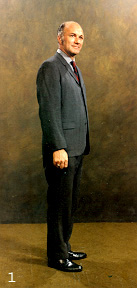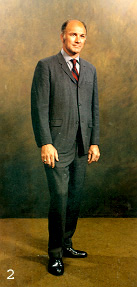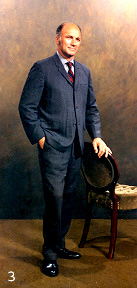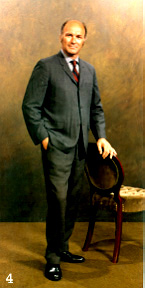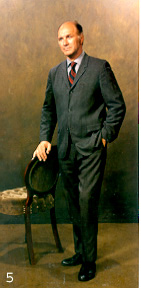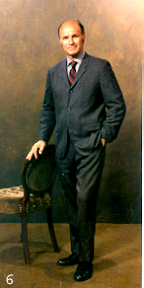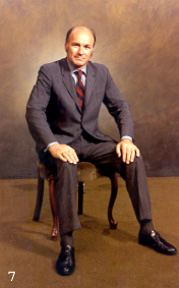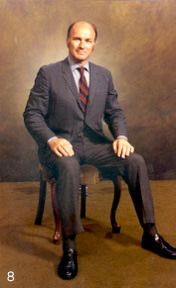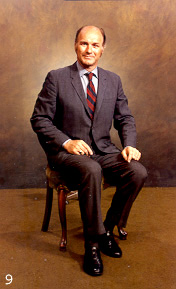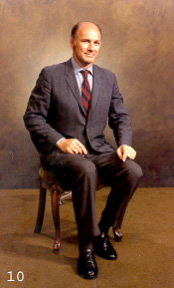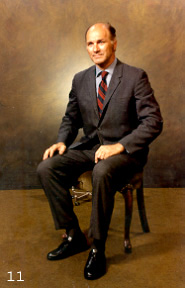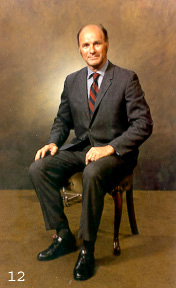|
The Zeltsman Approach to Traditional Classic Portraiture Chapter 4 Posing Men - Part One Introductory comments about my approach to Posing: I don’t begin a portrait sitting by posing the client! That, and the reason for it, is fully explained in the first five paragraphs in Chapter 3. My posing session therefore begins, after I’ve decided which of the subject’s views of the face I decide to feature, and I arrange the subject’s body into whatever pose that will effectively support the facial view being photographed. And that is what the four Chapters on Posing Men and Women will show you how to do. A reminder: This is Classic Portraiture posing, not posing by the "trial and error" method, or experimenting The essence of my approach to posing is that all poses are arranged into either one of TWO, distinctly different compositions. One I identify as a Masculine Composition, and the other as a Feminine Composition. No particular significance to those terms, other than to identify the structural difference between them. Note:Either composition may be used effectively to pose women and small children. But men are always posed in a Masculine Composition. To see the actual results of this approach to posing, look at the display of my portraits in Chapter 1, of men, women, children, babies, couples, in close-ups, three-quarter, and full length poses, singly or in groupings. Every person is posed in either a Masculine or Feminine composition. Everyone looks comfortable and natural, and certainly not as if they were manipulated into a pose. On to posing now! Full Length Standing Masculine Pose
The purpose of a full length pose is to show a subject’s figure. Yet, the turn to the side shown in this pose totally obscures the figure. The only salvageable portion of this pose is the subject’s face in a very close cropping. The absence of his far shoulder leaves the face floating without support. My reason for showing this pose is that I see it used very often in formal wedding groupings. Now, I will show you how to arrange a full length standing pose in a Masculine composition. First, about this pose: The subject’s body never faces the camera squarely, but is always turned slightly to the right or to the left, depending on which facial view is being photographed, and always showing the far shoulder and arm. (as in photo M-2).We’ll arrange that pose now in a step by step progression. Starting point: The subject is standing facing the camera squarely, feet side by side pointing front. To show the right two-thirds view of his face means the body must turn slightly to his left. He is then directed to keep his right foot as is, but to move his left foot back a bit, slightly behind the right foot, and in a bit of a turn to his left, as illustrated in the photo M-2. Step two: Now, he is directed to drop his weight on to his back foot, with a slight bend of his right knee. See photo M-2 His body is now turned exactly to where it needs to be, usually just the right amount. Should you feel however at this time, that you’d like to adjust that turn somewhat, all you do is ask the subject to turn his back foot just a bit to one side or the other, thus adjusting the body turn one way or another You’ve just learned that arranging of standing poses always begins by a particular placement of the subject’s feet on the floor.
Final steps: To ascertain that his exact two-thirds facial view is showing. And that the head is positioned precisely perpendicular to the line of the shoulders. The end result is an example of a classic full length standing Masculine Pose, that takes but a few minutes to arrange. You must surely be aware, as you look at this pose in photo M-3, that there are three great poses there. A close up head and shoulders. A three quarter length, cropped below the hands, and a full length. Each one is, of course, showing the subject’s two-thirds facial view. Now, without any change in the pose, a slight turn of the subject’s head to the front to show the exact front facial view, and you have the pose as shown in photo M-4. Again, the same three cropping options apply. That’s six choices provided by one single arrangement.
Photo M-5 shows exactly the same pose, reversed to support the subject’s left two-thirds facial view. The same Masculine Composition, arranged by the same placement of the feet, but in a reversed position, with the left foot in front now. And photo M- 6 is the same pose with head turned to show the front facial view. The same cropping options apply to each of the four poses M-3, M-4, M-5, M-6. That, by my count, offers a choice of 12 different portraits of that one Classic Masculine arrangement. Plus a variety of facial expressions??? A quick review: First step is the turn of the body. In a standing pose it is accomplished by the placement of the subject’s feet. Next step involves shifting the body weight onto the back foot by bending the front knee. Next step, the bending of the elbows to soften the lines of the arms and shoulders. Finally, the head is positioned perpendicular to the line of the shoulders. Full Length Seated Masculine Pose
Note: When seating someone in a chair, man or woman, you absolutely must never place the chair facing directly front. Always place it turned a bit to the right, or to left, depending on what facial angle you decided to photograph during a facial evaluation. As you probably realize now, since the subject’s body in a masculine pose must not be facing directly front, your placement of the chair will control the body turn in the direction you have planned. But when you ask a man to be seated, he usually disregards your placement of the chair, and plops down facing you, with legs apart, body slouched, and shoulders up hiding his neck (as illustrated in Photo M-7) We proceed now to arrange this full length seated masculine pose, step by step. 1. The posing session begins, by directing the subject to sit properly in the chair the way it is positioned. That places the body into the needed slight turn to his left, that will properly support either the full front, or the two-thirds side view of the face. 2. Now, as he is seated properly in the chair, ask him to sit up to his full height and a slight lean of the body in the direction it is facing. Note how this improved posture changed the appearance of the clothing, and giving shape and form to the body. 3. Because men normally sit with legs apart, they should be posed that way. But not as in photo M-8, with crotch area facing directly front toward the camera. Here is how to arrange this pose properly, still with his legs apart, as in photo M-9. First, when the subject sits in the pre-positioned chair properly, as shown here, it places the body in a slight turn to his left. That brings his right foot in line with his face, and his right knee in toward the center to cover the crotch area. His left foot is moved back slightly behind the front foot, almost like in a standing arrangement.
4. Now the hands resting on his lap are moved back until the elbows bend, to form the diagonal limes of the arms. 5. Finally, the turn of the head is checked to make sure the desired view of the face is related to the camera accurately, and the head is exactly perpendicular to the shoulder line. And that is the classic seated full length pose of a man in a masculine composition.
Photos M-11 and M-12 are exactly the same pose, in reverse, supporting the subject’s left two-thirds side view of the face, and the front view of the face. Final comments: In this Chapter, I dealt with posing the full length standing, and the full length seated Masculine Composition, for arranging family groups, or any other groupings, in traditional full length classic style. Go to next Chapter 5, Posing Men - Part Two, to see how this one masculine composition is used in arranging the traditional classic head and shoulders and three-quarter length poses. |
Rehosted on:

